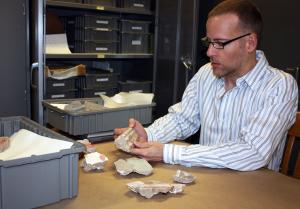
Tel Anafa Project: Publications on the joint excavations of the Museum of Art and Archaeology and the Kelsey Museum at the University of Michigan at Tel Anafa in the Upper Galilee region of Israel concludes soon with the final volume in the series. This volume will include a detailed analyses of the splendid stuccoed room on an upper floor of the Late Hellenistic Stuccoed Building (LHSB), a private villa belonging to wealthy, Phoenician merchants. A number of MU faculty and other scholars have published material in previous volumes encompassing pottery, glass, lamps, metals, and other small finds. MAA Curator of Ancient Art Benton Kidd’s study of the stuccoed room places the opulent plastered and gilded decoration, known as ‘Masonry Style,” into its historical context as well as analyzes its technical aspects such as pigments, gilding, and plastering methods. The MU Research Reactor Archaeometry Laboratory partnered with this study to perform chemical analyses. The most unusual result was recognition of mercury-enriched pink pigment, making the Tel Anafa villa (about 100 BCE) the earliest occurrence of a mercury-based pigment in the Levant. Additionally, greens tested as verdigris, the costly copper-rich pigment said to have been made by submerging copper in vinegar. Both mercury and copper are not native to Israel and attest the expense of this décor. Publication of the final volume in the Tel Anafa series is expected shortly.